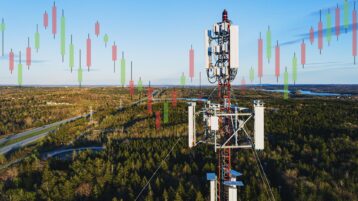It was another strong earnings quarter in Q4, with most companies beating expectations. But can they keep this up? Kim Parlee speaks with Ben Gossack, Portfolio Manager, TD Asset Management, about sectors and companies that may outperform in 2022 amid supply chain problems and sticky inflation.
Print Transcript
[AUDIO LOGO]
- We are about 80% now through the third quarter earnings season and there's been a whole lot of companies that have been exceeding expectations, but the question is, can they keep it up, especially with all the concerns about supply chains and continued inflation. Here to give us his take is Ben Gossack. He's portfolio manager with TD Asset Management, and he's standing by.
Ben, it's always great to catch up with you. Let me just jump right in here. We're seeing, I think, an earnings season so far average revenue growth of 16%, earnings per share growth of 38%, which are big numbers. But with a supply chain and inflation, are we going be able to keep that pace up?
- So it's obviously been another sort of record growth quarter. I think it's important to always compare. And what are we comparing ourselves to? And we're comparing ourselves to 2020 when the economy was shut down, and we were dealing with various waves of the coronavirus crisis. And so yes, we're getting 40% earnings growth. But the short answer is we should start to expect that growth to decelerate.
And there are known issues. So you brought up the supply chain issues, there are pricing pressure issues. So some people are worried about margins. There's either labor shortages going on, or there are strikes, or we're getting flare-ups of COVID. So either a port is being shut down or supply chains. But the basic math is that Q1 and Q2 of this year, earnings were growing 50% and 90% respectively.
- So even if there were no issues that we were worried about, just mathematically trying to lap a quarter where you grew by 90%, investors should expect that 2022 will be not the same amount of growth that we saw. It doesn't mean that the companies are struggling, it's just those are really tough comparisons to work against.
- Yeah, always got to watch the comps and what you're going up against. I want to bring up a graph that you brought in Ben, and showing us maybe some demand issues as well as supply issues. Maybe just tell us what we're looking at here, and why you think it's important.
- So this is something that we've been thinking about since the summer, but it's becoming more and more relevant. One feature, or one theme that really came up in Q3 was how companies were struggling with supply chain issues and shortages. And so what we're trying to capture here is, are these-- it was 100% of the problem or is some of the issues that companies are facing a demand problem? So we're looking at three curves,
The top curve is personal consumption and services. You can see because we've shut down the economy last year that spending in services has dived down, but we're just getting back to trend. I want people to highlight and focus their attention on the middle line. This is spending on goods. We're looking at 20 years of data, and so there's been this steady growth in goods.
And when I'm talking about goods, this is the stuff that you spend at home. So it's your cars, it's your home furnishing, it's your food and beverage that you would consume at home. This has been kind of slow and steady growth, but obviously we overindexed. We're well above trend because of the coronavirus crisis.
And so obviously, what we're expecting-- especially in 2022-- is that this is going to mean revert. So companies that make their business and goods may complain about a supply chain holding their ability to meet today's demand, but just from a historical perspective, we're well above trend and we have to mean revert.
And the last thing I wanted to highlight on this chart is that there is-- people are saying that they can't-- they're low on inventories, whether it's, let's say, a car dealer says my lot's empty. If you want a car, you have to wait months and months. From a dollar perspective, inventories across businesses in the US are actually back to where they were prior to the coronavirus crisis.
So what we're just trying to highlight here is that while companies might complain that they can't meet demand or their guidance is below expectations, we have to expect that on a goods basis, we need some mean reversion. But it also means there's an opportunity on the services side.
- I want to get into the services, but I just-- one thing that I know that you were telling somebody earlier that I was listening to is you talk about not inventory talking about just in time, but just in case ordering, which could I think put even more stress on the supply chain. Yes?
- Right. So right now, if you talk to the average supplier, they're saying their books are-- they're seeing multiples and multiples of orders. And you might say, wow, that's amazing demand coming through. But for the most part, manufacturing in the US has been in this just in time. So one item that meets the component to build a part comes as soon as you need it. You don't carry all this excess inventory. So think about your investments are not tied up into stuff sort of sitting on shelves, it was really great. But with COVID obviously, and COVID and chip shortages like I need this part I can't build it.
What I'm going to do now if I'm a purchasing manager, I'm going to order five parts because we're seeing supply come on, and then it comes off. And it could be for various reasons. It could be a port, it could be a ship, it could be COVID. And so people are, this just in case is, let's just order five, and so it's up to these manufacturers. Are they going to deliver on all five of those orders or just one? Because the risk is you have this inventory glut, and it might be great this year, but next year you won't sell as much.
- Yeah, I'm oversimplifying, but it's the toilet paper problem on a grand scale of people getting things ready and what that means. Listen we're up against the clock Ben, but I do want to mention for people who don't know, you do manage the TD Global Enhanced Dividend ETF TGED. You mentioned earlier when you were looking at the chart that services are looking interesting to you versus goods. And I understand that you like Hiltons. So maybe you could just tell me a bit about how that fits into your thesis.
- Right. So we think there's going to be a crossover event. It could be starting now especially into 2022 where spending at home will shift to outside of home. So again, we're talking about transportation, restaurants, travel and leisure. We think Hilton, it's completely the spending in terms of hotel lodging is still well below 2019 levels. So that's leisure, that's business travel.
So that's an area-- again, we're focused across our portfolio on services, any activity that's happening outside the home. So it could be Hilton, could be American Express, could even be like Estee Lauder, which is in skincare, but these are companies that could benefit from all this activity as we get back to normal in 2022.
- Ben, great to have you with us. Thanks so much.
- Great. Thanks, Kim.
[MUSIC PLAYING]
- We are about 80% now through the third quarter earnings season and there's been a whole lot of companies that have been exceeding expectations, but the question is, can they keep it up, especially with all the concerns about supply chains and continued inflation. Here to give us his take is Ben Gossack. He's portfolio manager with TD Asset Management, and he's standing by.
Ben, it's always great to catch up with you. Let me just jump right in here. We're seeing, I think, an earnings season so far average revenue growth of 16%, earnings per share growth of 38%, which are big numbers. But with a supply chain and inflation, are we going be able to keep that pace up?
- So it's obviously been another sort of record growth quarter. I think it's important to always compare. And what are we comparing ourselves to? And we're comparing ourselves to 2020 when the economy was shut down, and we were dealing with various waves of the coronavirus crisis. And so yes, we're getting 40% earnings growth. But the short answer is we should start to expect that growth to decelerate.
And there are known issues. So you brought up the supply chain issues, there are pricing pressure issues. So some people are worried about margins. There's either labor shortages going on, or there are strikes, or we're getting flare-ups of COVID. So either a port is being shut down or supply chains. But the basic math is that Q1 and Q2 of this year, earnings were growing 50% and 90% respectively.
- So even if there were no issues that we were worried about, just mathematically trying to lap a quarter where you grew by 90%, investors should expect that 2022 will be not the same amount of growth that we saw. It doesn't mean that the companies are struggling, it's just those are really tough comparisons to work against.
- Yeah, always got to watch the comps and what you're going up against. I want to bring up a graph that you brought in Ben, and showing us maybe some demand issues as well as supply issues. Maybe just tell us what we're looking at here, and why you think it's important.
- So this is something that we've been thinking about since the summer, but it's becoming more and more relevant. One feature, or one theme that really came up in Q3 was how companies were struggling with supply chain issues and shortages. And so what we're trying to capture here is, are these-- it was 100% of the problem or is some of the issues that companies are facing a demand problem? So we're looking at three curves,
The top curve is personal consumption and services. You can see because we've shut down the economy last year that spending in services has dived down, but we're just getting back to trend. I want people to highlight and focus their attention on the middle line. This is spending on goods. We're looking at 20 years of data, and so there's been this steady growth in goods.
And when I'm talking about goods, this is the stuff that you spend at home. So it's your cars, it's your home furnishing, it's your food and beverage that you would consume at home. This has been kind of slow and steady growth, but obviously we overindexed. We're well above trend because of the coronavirus crisis.
And so obviously, what we're expecting-- especially in 2022-- is that this is going to mean revert. So companies that make their business and goods may complain about a supply chain holding their ability to meet today's demand, but just from a historical perspective, we're well above trend and we have to mean revert.
And the last thing I wanted to highlight on this chart is that there is-- people are saying that they can't-- they're low on inventories, whether it's, let's say, a car dealer says my lot's empty. If you want a car, you have to wait months and months. From a dollar perspective, inventories across businesses in the US are actually back to where they were prior to the coronavirus crisis.
So what we're just trying to highlight here is that while companies might complain that they can't meet demand or their guidance is below expectations, we have to expect that on a goods basis, we need some mean reversion. But it also means there's an opportunity on the services side.
- I want to get into the services, but I just-- one thing that I know that you were telling somebody earlier that I was listening to is you talk about not inventory talking about just in time, but just in case ordering, which could I think put even more stress on the supply chain. Yes?
- Right. So right now, if you talk to the average supplier, they're saying their books are-- they're seeing multiples and multiples of orders. And you might say, wow, that's amazing demand coming through. But for the most part, manufacturing in the US has been in this just in time. So one item that meets the component to build a part comes as soon as you need it. You don't carry all this excess inventory. So think about your investments are not tied up into stuff sort of sitting on shelves, it was really great. But with COVID obviously, and COVID and chip shortages like I need this part I can't build it.
What I'm going to do now if I'm a purchasing manager, I'm going to order five parts because we're seeing supply come on, and then it comes off. And it could be for various reasons. It could be a port, it could be a ship, it could be COVID. And so people are, this just in case is, let's just order five, and so it's up to these manufacturers. Are they going to deliver on all five of those orders or just one? Because the risk is you have this inventory glut, and it might be great this year, but next year you won't sell as much.
- Yeah, I'm oversimplifying, but it's the toilet paper problem on a grand scale of people getting things ready and what that means. Listen we're up against the clock Ben, but I do want to mention for people who don't know, you do manage the TD Global Enhanced Dividend ETF TGED. You mentioned earlier when you were looking at the chart that services are looking interesting to you versus goods. And I understand that you like Hiltons. So maybe you could just tell me a bit about how that fits into your thesis.
- Right. So we think there's going to be a crossover event. It could be starting now especially into 2022 where spending at home will shift to outside of home. So again, we're talking about transportation, restaurants, travel and leisure. We think Hilton, it's completely the spending in terms of hotel lodging is still well below 2019 levels. So that's leisure, that's business travel.
So that's an area-- again, we're focused across our portfolio on services, any activity that's happening outside the home. So it could be Hilton, could be American Express, could even be like Estee Lauder, which is in skincare, but these are companies that could benefit from all this activity as we get back to normal in 2022.
- Ben, great to have you with us. Thanks so much.
- Great. Thanks, Kim.
[MUSIC PLAYING]


























